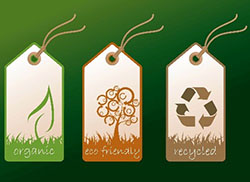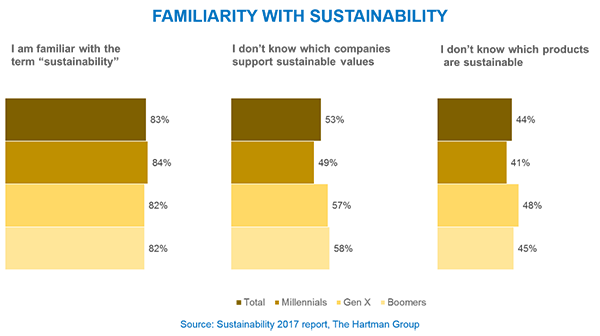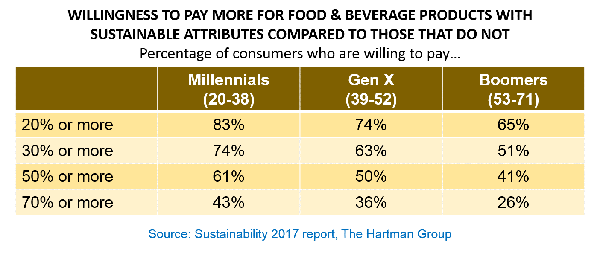Sustainability and Boomers: All Talk, No Walk?
 The Brief
The Brief
Baby Boomers may have started the environmental movement and are well-versed in articulating what sustainability means, but younger consumers let their actions (purchasing behaviors) speak for them. The Hartman Group’s Sustainability 2017 report establishes that there is significant disparity among consumer segments between attitudes about sustainability and willingness to pay more for sustainable products. Which consumers are willing to pay more? The answer may surprise you.
High familiarity with the term, but not so much with naming a sustainable company
Lest we forget, sustainability did not originate in the consumer world. “Sustainability” as a term quickly became shorthand for sustainable development as the concept became ubiquitous in the everyday discourse of various lending agencies, academics, NGOs and governments. It was these groups that introduced the concepts into the corridors of corporations throughout the world and then into the domestic sphere.
In the past decade, from 2007 and our seminal research in understanding the consumer perspective on sustainability to our Sustainability 2017 report, we see awareness of, and familiarity with, sustainability continuing to grow, reaching an all-time high of 83 percent in 2017 (compared with 54 percent in 2007).
While consumers’ familiarity with the term “sustainability” has grown, the following chart depicts that still in 2017 many consumers have difficulty identifying products or companies that are sustainable.
Consumer-defined dimensions of sustainability roughly align with The Hartman Group’s four overlapping zones of responsibility — personal, social, environmental and economic. More engaged consumers identify sustainability with all four zones of responsibility, but there are differences by generation. Boomers link sustainability more strongly with environmental values, such as conserving natural resources, responsible farming methods, reducing carbon footprint, environmentally friendly, “recycle, reuse, reduce” and maintaining a clean water supply. Millennials are more likely to see it through the lens of personal responsibility, viewing attributes like organic and all-natural as both sustainability and quality cues.
Walking the talk: who’s buying into sustainability with their purchases?
Sustainability has been a promising segment for years. Yet companies struggle to figure out how to convert familiarity and sentiment into purchases. As the chart suggests, overcoming consumers’ lack of knowledge is the key to unlocking sales potential for sustainable products and services.
Consumers are learning more about sustainability but are not really putting any money where their feelings are yet. While more than a quarter of consumers claim that environmental and social concerns impact much of their purchasing, which consumers are likely to pay more for products with sustainable attributes and how much more are they willing to pay?
The following chart shows that Boomers’ strong connections to environmental values in understanding and sentiment do not get them reaching into their wallets to put extra dollars toward purchasing products with sustainable attributes. Younger consumers, Millennials specifically, are the most willing to pay more for products with sustainable attributes, possibly as a reflection of their belief that if it is “better for me, then it is better for the world.”
Cultural Pulse
Consumers want to feel good about what they’re buying. Communicating sustainability efforts more effectively is likely an opportunity to capture consumers’ attention. Some companies are reticent about touting their sustainability efforts. Most consumers want to know this information. It’s important to convey that you are trying — with goals and measurements.
We believe it is necessary to focus on sustainability at the category level, rather than at the company level. Why the category level?
Even though consumers want to be sustainable, sustainability takes a back seat to the other concerns consumers have in their personal lives. For most consumers, it is often too complicated for them to weigh up every dimension of responsibility for every portion of the product cycle for every product they buy. While consumers want to make sustainable purchases, they also want the decision-making process to be less complex.
About Sustainability 2017 Report
Sustainability 2017 tracks and investigates how consumers understand, prioritize and connect four zones of responsibility (personal, social, environmental and economical), exploring differences between consumer demand for and actual purchasing of sustainable products, and attitudes toward corporate transparency issues. The report updates understandings of their evolving attitudes, behaviors and aspirations regarding sustainability, including category adoption and the ways in which sustainability and transparency concepts manifest in consumer discourse. DOWNLOAD OVERVIEW AND ORDER FORM


